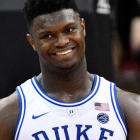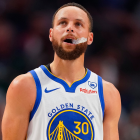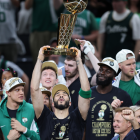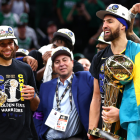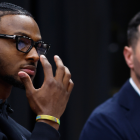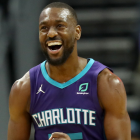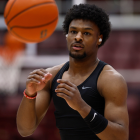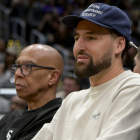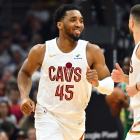By the time the NBA Draft arrives each year, there's typically something close to a consensus about what the franchise picking first should do with the No. 1 overall pick. But that doesn't usually come until after the college basketball season - evidence being how, this time last year, folks were still debating Deandre Ayton, Marvin Bagley and Luka Doncic even though, in the weeks leading up to the 2018 NBA Draft, most analysts and front offices had, for better or worse, settled on Ayton as the best available option.
I say all that to say this: we already have a consensus this year.
I really don't think you could find a single general manager who would, if the draft were happening tonight, do anything with the first pick other than use it to select Duke star Zion Williamson -- mainly because the one-and-done phenom has so clearly established himself as the most unique prospect in the world. Sure, there are questions about him; he's not perfect. But he's a 6-foot-7 forward who can do so many things that normal humans can't do, and who is such an international superstar already, that passing on him would make no sense from a basketball or business perspective. If another prospect ends up being better, say five years from now, well, that's just the way drafts go sometimes. But only one player available can flip a franchise overnight. And that player, no reasonable person disagrees, is Zion -- the biggest one-name star college basketball has had in a while.
Here's my latest mock draft with the draft order set by SportsLine's NBA projected standings.
| 1 | |
Zion Williamson | Duke | Fr | PF | 6-7 Williamson is a top-shelf athlete who can do things at his height (6-7) and weight (285 pounds) literally nobody else on the planet his height and weight can do. He's fast, explosive, nimble, powerful and way more than the YouTube dunker most perceived him to be coming out of high school -- evidence being how his Player Efficiency Rating is significantly higher than anybody else's in college basketball. The main concerns are whether his low 3-point shooting percentage will be a long-term issue, and if he can manage his body well enough to flourish and develop into a star. Those are fair questions to ask, I guess. But they're not the type of questions that'll prevent Williamson from going first in this draft. | |
| 2 | |
RJ Barrett | Duke | Fr | SG | 6-7 Barrett is the player most had projected as the No. 1 pick in the preseason. And he didn't lose that spot as much as his teammate took it -- because Barrett is having a tremendous freshman season. He's averaging 23 points and seven rebounds thanks in part to six different 30-point performances. The 6-7 freshman isn't the most efficient player in the country, but he's a relentless scorer who should be able to get buckets in the NBA from the jump. His unreliable jumper leaves something to be desired, sure. But Barrett's ability to play on or off the ball, and his willingness and ability to takeover games, makes him the best and safest option once Williamson is off the board. | |
| 3 | |
Ja Morant | Murray St. | Soph | PG | 6-3 It's true that Cleveland used a lottery pick on a point guard last season. But that shouldn't prevent the Cavaliers from taking Morant if he's available here. The 6-3 sophomore has arguably helped himself with NBA scouts this season more than any other projected top-10 pick because he's proven to be incredibly difficult, bordering on impossible, for opposing guards to keep out of the lane -- which is why more than half of Morant's field goal attempts come at the rim, where he finishes successfully more than 62 percent of the time. Morant is averaging 24 points and 10 assists even though he's shooting just 34 percent from 3-point range since entering college. That last stat isn't great. But the comp Morant gets most is Oklahoma City star Russell Westbrook. And, remember, Westbrook only shot 35 percent from beyond the arc in two seasons at UCLA. | |
| 4 | |
De'Andre Hunter | Virginia | Soph | SF | 6-7 Hunter is a 6-8 forward who measures similarly to OG Anunoby, can switch on to bigs or guards no problem, and is shooting nearly 50 percent from 3-point range this season for a school that's about to be a No. 1 seed in the NCAA Tournament for the second straight year. It's hard, bordering on impossible, to come up with reasons why he won't be very good, if not great, at the next level. I've heard former NBA players who are now television analysts describe Hunter as the Kawhi Leonard of this draft. I can't promise that, exactly. But if their point is that Hunter projects as a tremendous two-way player, yeah, that's a fair assessment. | |
| 5 | |
Cam Reddish | Duke | Fr | SF | 6-8 If Reddish goes in the top five, Duke will become the first program in college basketball history to have three top-five picks in the same draft. That's an achievement that'll be a recruiting tool for years to come -- and it's also a reminder of why Duke is the favorite to win the 2019 NCAA Tournament. The Blue Devils are just significantly more talented than everybody else. As for Reddish specifically, his shot looks fine but he's never really made a good percentage of his 3-point attempts. That's a concern. But the 6-8 wing has great size for his position and can hurt the opposition in a variety of ways. | |
| 6 | |
Darius Garland | Vanderbilt | Fr | PG | 6-2 The Grizz kept Mike Conley through the trade deadline but will maybe shop him again this offseason while committing to a full and necessary rebuild. In other words, Memphis needs to find its point guard of the future. (Jevon Carter isn't it.) So selecting Garland would make a lot of sense -- even if he is coming off of season-ending knee surgery, which is less-than-ideal for a franchise that is still dealing with the Chandler Parsons' contract that's a mistake because of, you guessed it, bad knees. It might be a hard sale for the fans. But Garland is such a fabulous talent he'd have to be considered. Great with the ball. Tremendous shooter. If he develops into an All-Star, it won't surprise me. | |
| 7 | |
| Nassir Little | North Carolina | Fr | SF | 6-6 Pick via Dallas: Little was the MVP of the 2018 McDonald's All-American Game and the 2018 Jordan Brand Classic. So it's reasonable to suggest most didn't expect him to be averaging fewer than 10 points per game in his freshman season at North Carolina. But that's exactly what he's doing -- at least partly because he's playing fewer than 20 minutes per game and behind a pair of seniors in Cameron Johnson and Luke Maye. It just hasn't been a good fit from a roster perspective. Regardless, scouts are still intrigued by Little's natural gifts and potential. So while he won't be picked where he would've been selected before this season started, he'll still be picked in the lottery, barring a surprise. | |
| 8 | |
Jarrett Culver | Texas Tech | Soph | SG | 6-6 Culver projects as the second straight sub-100 high school prospect to develop into a top-20 pick within two years of enrolling at Texas Tech, which speaks volumes about the development happening inside Chris Beard's program. The 6-6 sophomore has above-average size for a guard — and he's capable of guarding at least three positions. That's the good. But the release on his jump shot is slower than it should be; it needs work. So that's the bad. But Culver is a highly productive player for a very good team and solid second-tier prospect who should not drop outside of the top 10. | |
| 9 | |
Romeo Langford | Indiana | Fr | SG | 6-6 Langford is a natural scorer from the wing who is difficult to contain off the dribble. He gets to the rim, finishes near the basket and draws fouls -- all of which should translate to the NBA. The fact that the 6-6 guard is shooting well under 30 percent from 3-point range is an obvious concern because wings who can't shoot aren't great fits in the modern-NBA. But most believe there's no reason Langford can't become a respectable shooter in time, at which point he could become the same type of reliable scorer in the NBA that he's been at every level of basketball so far in his life. | |
| 10 | |
Rui Hachimura | Gonzaga | Jr | PF | 6-8 Hachimura has gone from somebody who averaged 4.6 minutes per game as a freshman to an undeniable lottery prospect as a junior who is shooting above 60 percent from the field, and above 45 percent from 3-point range, for a Gonzaga team that finished the regular season 29-2 and ranked No. 1 in the AP poll. The 6-8 forward is perfect for the modern NBA. He didn't start playing basketball in his native Japan until his teenage years -- and he's improved significantly, in every way, every year in college. So there's no reason to think Hachimura won't continue to get better at all of the things he's already good at, which is among the reasons he is a reasonable option in the top 10. | |
| 11 | |
Jaxson Hayes | Texas | Fr | C | 6-11 Hayes developed late and was labeled as just the third-best prospect in Texas' four-player recruiting class coming out of high school. He was merely a borderline top-100 recruit. But the 6-11 forward showed tremendous ability early this season and established himself as a lottery talent with incredible upside. Hayes is shooting above 70 percent from the field — mostly because he dunks anything close to the rim. His block percentage of 10.9 rates 19th nationally. And it should be noted that Hayes is also the son of a former professional athlete, which sometimes means nothing but is definitely something more and more NBA franchises have come to value thanks to players like Stephen Curry and Jaren Jackson Jr. | |
| 12 | |
Keldon Johnson | Kentucky | Fr | SG | 6-6 There are two Kentucky freshmen who were rated higher than Johnson coming out of high school — but it's Johnson who should be the first Wildcat taken in this draft. The 6-6 wing is a good-enough athlete who is shooting nearly 40 percent from 3-point range on three attempts per game. He's a big reason why Kentucky looks nothing like the team that opened this season with a 34-point loss to Duke. It's true that Johnson's production has decreased a bit as the season progressed. But he's still worthy of being selected in the lottery of this draft that drops off considerably somewhere inside the top 10. | |
| 13 | |
Nickeil Alexander-Walker | Virginia Tech | Soph | SG | 6-5 Alexander-Walker made a significant jump from his freshman season to his sophomore season and is now averaging 16 points per game while shooting nearly 40 percent from 3-point range for a Virginia Tech team that's been ranked in the top 20 pretty much this entire season. More importantly, for his NBA future at least, Alexander-Walker has shown he's a 6-5 guard capable of playing on or off the ball. He can guard at least three positions. And he's also a smart player with a high basketball IQ who sees the floor well. All of this is why NBA scouts have been buzzing about him since November. | |
| 14 | |
Sekou Doumbouya | France | SF | 6-9 Pick via Sacramento : Doumbouya should be the first non-college player selected. The 6-9 forward was born in Guinea but raised in France. He just turned 18 in December and will get lottery looks because he's an athlete who can really run the floor and play above the rim. His high-arcing jumper has never gone in consistently enough for anybody to call Doumbouya a reliable shooter. But there's no obvious reason he can't develop into a reliable shooter and become a high-level two-way player when he moves from the top professional league in France to the NBA. | |
| 15 | |
Jontay Porter | Missouri | Soph | C | 6-11 Porter tore his ACL and MCL in the preseason and obviously hasn't played since. So, if he chooses to enter the 2019 NBA Draft, he'll do so while coming off of an injury just like his brother, Michael Porter Jr., did last year. It's terrible luck for a decent family. But a torn ACL/MCL shouldn't be nearly as concerning for franchises as a sketchy back. So this 6-11 center who is plenty skilled enough to be a stretch-5 in the modern NBA should still find himself on the radar of any team selecting around the back end of the lottery. | |
| 16 | |
KZ Okpala | Stanford | Soph | SF | 6-9 Okpala's production is significantly up over where it was last season. The 6-9 forward is averaging 17 points and making 38 percent of the three 3-pointers he's attempting per game. He's transformed from a borderline top-45 prospect in the Class of 2017 into a possible top-20 pick in the 2019 NBA Draft. One of the keys to that, it should be noted, is that he's gone from a 6-6 forward to a 6-9 forward in a span of two years. Now Okpala looks like a nice combo-forward for the modern-NBA. | |
| 17 | |
Brandon Clarke | Gonzaga | Jr | PF | 6-8 Williamson, as noted above, has the highest Player Efficiency Rating in college basketball. It's roughly five points better than anybody else's. But Clarke has the sport's second-best PER -- one that's roughly three points better than everybody else's. And he's a big reason why Gonzaga finished a perfect 16-0 in the West Coast Conference. The 6-8 forward averaged 16 points and eight rebounds in the regular season while shooting 68 percent from the field and blocking more than three shots per game. The San Jose State transfer is a high-energy big who is a plus-player on both ends of the court. Any franchise obsessed with advanced stats, which is most, will seriously consider him anywhere outside of the top 10. | |
| 18 | |
PJ Washington | Kentucky | Soph | PF | 6-8 Pick via Los Angeles Clippers: Not all freshmen who return to school for their sophomore seasons to improve their stock, actually, you know, improve their stock. But Washington has definitely helped himself this season -- mostly because the 6-8 forward has gone from a 24 percent 3-point shooter (on limited opportunities) to somebody who is shooting above 40 percent from beyond the arc, which is among the reasons he's the leading scorer for a Kentucky team that's recovered brilliantly from its season-opening blowout loss to Duke. Washington is also UK's leading rebounder. So he's far more than a one-dimensional prospect and way better equipped to be picked this year than he was last year.. | |
| 19 | |
Bol Bol | Oregon | Fr | C | 7-2 Bol is probably the most polarizing prospect in this draft. On one hand, he's a 7-2 center who can put the ball on the floor, shoot 3-pointers effectively and alter and block shots like nobody else available. On the other hand, he's a 7-2 center who struggles to guard in space and missed most of this season after suffering a foot injury in December that required surgery in January. Some franchises will have him in the top 10, others outside of the top 20. Exactly where Bol will land in June is one of this draft's greatest mysteries. | |
| 20 | |
Coby White | North Carolina | Fr | PG | 6-5 Perhaps it should be unsurprising that the leading scorer in the history of North Carolina high school basketball is scoring in big numbers as a freshman at UNC. But, still, I'm not sure many expected White, a sub-20 prospect in the Class of 2018, to pass Michael Jordan on the school's freshman scoring list in early March and play this big of a role for a North Carolina team that spent February building a resume that lifted the Tar Heels into the top five of the AP poll. Before the season, White was considered a 6-5 shooting guard. But he's shown the ability this season to effectively play with or without the ball, which has made him an even more intriguing prospect than he otherwise would be. | |
| 21 | |
Bruno Fernando | Maryland | Soph | PF | 6-10 Fernando, already blessed with an NBA-ready body, has been extremely tough for Big Ten post players to deal with all season. He's averaging 14 points and 10 rebounds per game. One coach even compared him to Karl Malone. And while I'm not sure the 6-10 forward projects as a future Hall of Famer like The Mailman eventually became, it's hard not to like an athlete built this way who also has a motor that allows him to work harder, and play harder, than most of the other bigs he's spent the past two seasons matched up against. | |
| 22 | |
Kevin Porter Jr. | USC | Fr | SG | 6-6 From a basketball perspective, Porter is a lottery talent who would be a steal for the Jazz, or anybody else, this low in this draft. But he's done very little, and possibly nothing, to eliminate some of the red flags that figure to make selecting him in the lottery a non-starter for some -- not all, but definitely some -- franchises. The 6-6 wing has been injured. He's been suspended. He's been something less than the model student-athlete. And though none of that alone means Porter won't emerge as one of the 10 best players from this draft, some of that is why he's unlikely to be one of the top 10 players selected in this draft. | |
| 23 | |
Tyler Herro | Kentucky | Fr | SG | 6-5 Pick via Houston: Herro has done a nice job this season proving he's way more than "just a shooter" -- which is what many labeled him coming out of high school, perhaps because of little more than stereotypes. At Kentucky, the 6-5 freshman is second in scoring, second in assists, fourth in rebounding and second in minutes played. He's shooting nearly 40 percent from 3-point range and above 90 percent from the free throw line. So he's a guard with size who can put the ball on the floor and consistently knock down shots. And there just has to be a spot for a player like that in an NBA that values shooting more than ever these days. | |
| 24 | |
Ty Jerome | Virginia | Jr | PG | 6-5 Show me a smart player with good size for his position who can play either backcourt spot, dribble, pass, shoot and be tough on the defensive end of the court, and I'll show you somebody who will have a long career playing professional basketball. Jerome is such a player. He's a 6-5 combo guard who is shooting 43 percent from beyond the arc and posting a steal rate of 2.9. Those are both nice numbers. And the success other recent Virginia alums have had in the NBA can't possibly hurt him with front offices looking to avoid a mistake. | |
| 25 | |
Admiral Schofield | Tennessee | Sr | SG | 6-6 Schofield was just a 3-star prospect coming out of high school -- a 6-5 forward from Illinois who wasn't even considered a top-250 recruit, according to 247Sports, in the Class of 2015. Now he's 6-6 with a sculpted body and reputation for being a tireless worker who is loved by his coaches. The development is incredible. Schofield is averaging 16 points and six rebounds this season for a Tennessee team that spent four weeks ranked No. 1. The fact that he has consistently shot around 39 percent from 3-point range for three consecutive seasons suggests he'll also be a real threat from the perimeter when he gets to the NBA. | |
| 26 | |
Tre Jones | Duke | Fr | PG | 6-2 Jones is, by a significant margin, the least-celebrated freshman in Duke's starting lineup. But talk to the coaching staff and they'll tell you the 6-2 point guard is just as important to the Blue Devils' success as pretty much anybody else. His feel for the game is unusual for a first-year college player. His instincts are excellent. The way he pressures the ball defensively, every second of every game, is the reason Duke's defensive-efficiency rating ranks in the top 10 nationally. There are better athletes at the position, absolutely -- and way better shooters. But the other stuff Jones provides is so valuable somebody will grab him in the first round. | |
| 27 | |
Grant Williams | Tennessee | Jr | PF | 6-7 Williams is a two-time SEC Player of the Year and so great that Tennessee has a real chance to win a national championship even though there isn't a single former top-100 prospect on the roster. And he's been so productive this season that NBA scouts who previously questioned whether what he does will translate to the next level are starting to wonder why it won't. The 6-7 forward is neither a great athlete, nor a serious threat from the perimeter. But he really, really knows how to play. And, more and more often, players who are described that way are carving out roles for themselves in the NBA. Perhaps Williams can be the next. | |
| 28 | |
Luguentz Dort | Arizona State | Fr | SG | 6-4 Pick via Toronto: Dort became just the third consensus top-50 high school prospect to enroll at Arizona State -- joining a list that includes James Harden and Jahii Carson -- and he's a big reason the Sun Devils are about to make the NCAA Tournament for the second straight year under Bobby Hurley. The 6-4 freshman from Montreal is averaging 16 points and getting to the free throw line more than six times per game. He has a 6-9 wingspan and real desire to guard both quicker and bigger players. His 215-pound frame is put together better than the frames most college freshmen carry around. And although Dort is not a natural point guard, he's spent part of this season proving he can play on or off the ball. | |
| 29 | |
Daniel Gafford | Arkansas | Soph | C | 6-11 Gafford's minutes and production are up from what he was getting and doing as a freshman at Arkansas. But the 6-11 forward still mostly just does what he does and little else -- which means he dunks everything around the rim, blocks shots at a percentage that ranks in the top 40 nationally but remains something less than the type of skilled big NBA franchises now prefer. To be clear, Gafford's positive attributes and natural gifts should keep him in the first round; I'm nitpicking a little here. But some believed he'd return to Arkansas for one more year and leave as a lottery pick, and that just doesn't, at this point, seem like a likely scenario. | |
| 30 | |
Eric Paschall | Villanova | Sr | 6-8 Villanova needed Paschall to elevate his play to stay relevant and win a fifth Big East title in a six-year span. He did. So the Wildcats did. And the 6-8, 260-pound senior has, in the process, helped himself with NBA scouts. Yes, he'll turn 23 in November, which works against him. But his body is built to compete in the NBA right now. And this season has allowed Paschall to prove he's more than just a role player on a team with four future NBA players -- which is kind of what he was last season -- while averaging career-high numbers in points, rebounds and 3-point percentage. | |


































